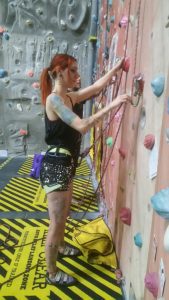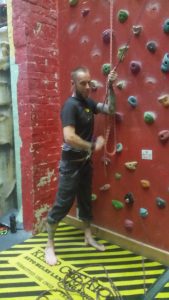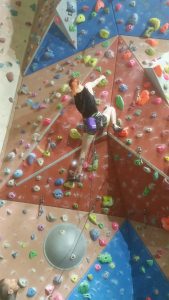Doing an indoor sport lead course is a great way to improve your climbing technique, make your climbing experience more challenging and more interesting. Most climbers learn to climb indoors using preplaced top ropes, but the only way forward is to do harder routes which you can only climb if there is a top rope in place, so your selection of climbs is limited.
Syndi and Jim have been climbing for just over a year and began with a beginner climbing course but Syndi in particular wanted to move on to the next stage. Every course with Ali is taylored to the needs of the individuals and is not a set course. Clients can advance as quickly as their confidence and ability allows and all aspects of the course are progressive. It begins with a top roping session to relax the climbers into familiar territory but with the added dimension of the climber down climbing and the belayer paying out to simulate giving rope when lead belaying.

An introduction to quick draws allows the climbers get to grips with types, length, and clipping techniques – all with their feet firmly planted on the floor, using only one hand and clipping from left and right. Most climbing centres have quick draws in place but some centres do have lines with bolts only which is great practice for when you move outdoors.
The next step is to mock lead which is done with 2 belayers – one top roping and one lead belaying. You could also just trail a lead rope to get the hang of it first but if you are with a qualified and experienced instructor like Ali they can top rope the climber whilst the other client gets the opportunity to lead belay without any safety concerns for the belayer or the climber.
Lead belaying is a difficult skill to master quickly and it takes many years to become an expert – like any skill. Both climber and belayer need to cooperate with each other at this stage, maintain good communication and remain relaxed. If you become tense whether belaying or climbing the whole process becomes so much more difficult as all your energy is going into tension particularly in the neck and shoulders. The secret is to breath in deeply and as you breath out let the body relax. It is a good technique to learn and becomes very useful when leading outdoors when the bolts are often greatly spaced. Breathing generally is underrated!!
Some climbers pick skills up quicker than others and are ready for the next stage. If you have an instructor who is pushing you to do more than you are comfortable with they are obviously not reading your signals which may lead to an an early accident and could put you off for life. Lead climbing has greater risks than top roping as the lead climber could hit the ground from even the 4th clip OR anywhere if the belayer is not doing their job properly.

The first lead climb is usually the most nerve wracking as is the first lead belay, but with Ali on hand to give encouragement and step in if things go pear shaped all basis are covered. The climber uses any hold to find the stability to clip each quick draw in succession and the belay at the top. Once back on the ground the relief and euophoria are palpable.
Some climbers do not progress past the mock leading stage and the transition is definitely easier the more top rope climbing experience you have before you consider lead climbing, as the muscle memory has developed for climbing. Footwork is even more important when lead climbing as you must transfer all your weight onto your feet in order to clip securely. Climbers who climb mainly with their arms have greater difficulty clipping and are often extremely pumped leading the easiest of routes.
The only way to lessen your fear and move your comfort zone into the learning/adventure/growth zone is to practice the skills you have learnt, by rainbow lead climbing to start, progressing to easy coloured routes and gradually increasing the grade.
Syndi and Jim had a very demanding day both physically and mentally, and were amazed at how complex lead climbing and belaying was and how much they learnt. The final task of the day was to learn how to fall off and how to belay a lead fall, on a loose top rope to start and on the sharp end. Jim took a real leader fall, which actually improved his confidence as it was over before it started and nothing really happened due to Syndi’s expert belaying. Syndi on the otherhand ascended the Competition Wall for her forced fall but enjoyed it so much she did it again……..
